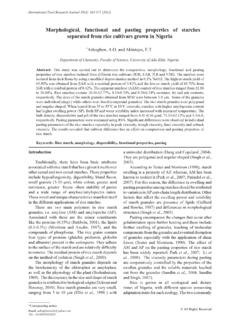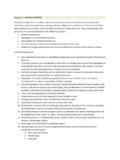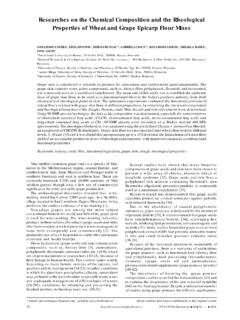Transcription of 2004-10-20 CTA 63 Benzoyl peroxide - Home | Food and ...
1 chemical and Technical Assessment 61st JECFA. Benzoyl peroxide chemical and Technical Assessment (CTA). First draft prepared by Yehia El-Samragy FAO 2004. 1 Summary Benzoyl peroxide (BP) has been used for over 50 years as a bleaching agent in flour, whey processing and milk for Italian cheese making. It was used for bleaching flour and cheese at concentrations of up to 40. mg/kg, while bleaching of Cheddar cheese whey has been done successfully using 20 mg/kg BP and holding for an hour at 60-63 C. As Benzoyl peroxide is almost totally converted (> 91%) to benzoic acid during cheese making and any remaining traces would further be reduced by processing of whey. Therefore the intake assessment should be made on the additional benzoic acid incorporated in the diet from the use of Benzoyl peroxide to bleach whey. JECFA has evaluated the use of BP as a bleaching agent in flour and concluded that treatment at concentrations up to 40 mg/kg was acceptable (WHO, 1964). Moreover, at the 59th meeting JECFA.
2 Concluded that Benzoyl peroxide was of "no safety concern" when used as a flavouring agent (based on current levels of intake) (WHO, 2002). Concentration of Benzoyl peroxide commercially used is much lower than 100 mg/kg. Only 15% of the world's cheese production is coloured and hence is subject to use BP. Besides, not all of the coloured whey undergoes bleaching process before drying. 2 Description Benzoyl peroxide is colourless, crystalline solid having a faint odour of benzaldehyde. It is insoluble in water, slightly soluble in alcohol, and soluble in chloroform and ether. One g dissolves in 40 ml of carbon disulfide. It melts between 103 C and 106 C with decomposition. Benzoyl peroxide , especially in the dry form, is a dangerous, highly reactive, oxidizing material and has been known to explode spontaneously. 3 Manufacturing Benzoyl peroxide is synthesized commercially by the reaction of Benzoyl chloride, sodium hydroxide, and hydrogen peroxide . Traces of benzoic acid remain after usual purification procedures.
3 4 chemical Characteristics Nomenclature and physical properties The chemical names are Benzoyl peroxide or dibenzoyl peroxide . Its chemical Abstract Service (CAS). number is 94-36-0 and International Numbering System (INS) is 928, its chemical formula is C14H10O4, and its molecular weight is The chemical structure is shown in figure 1. 1 (6). chemical and Technical Assessment Benzoyl peroxide 61st JECFA. Figure 1. Structural formula of Benzoyl peroxide The physical properties of Benzoyl peroxide reported in (FNP5) indicates that it is insoluble in water, slightly soluble in ethanol, soluble in ether and chloroform. It has a melting range of 103 - 106 C with decomposition. Analytical Methods Method of assay Dissolve about 250 mg of the sample, accurately weighed, in 15 ml of acetone in a 100-ml glass-stoppered bottle. Add 3 ml of 50% (w/v) potassium iodide solution and swirl for 1 min. Titrate immediately with N. sodium thiosulfate (without addition of starch as an indicator). Each ml of N sodium thiosulfate is equivalent to mg of C14H10O4.
4 Methods of determination of Benzoyl peroxide (as benzoic acid) in foods Determination of Benzoyl peroxide in flour The method described in AOAC is used to determine Benzoyl peroxide in flour (AOAC, 1998). Determination of Benzoyl peroxide in this method depends on its ether extraction. Another method have been developed by Feigl et al. (1961) to detection of Benzoyl peroxide through the pyro-oxidation of hexamine (limit of detection is 10 g Benzoyl peroxide ). In this method, a drop of the sample or its solution in benzene is placed in a micro test tube. Three drops of 5% solution of hexamine in benzene are added and the mouth of the test tube covered with a disc of filter paper moistened with Nessler's reagent. The tube is then immersed to 3/4 of its length in a 100 C glycerol bath that may be heated to 130 C without danger of explosion. The development of a grey or black stain on the reagent paper indicates a positive response. Also, Saiz (2001) developed a method to analyze Benzoyl peroxide in flour using HPLC.
5 Fifty grams of flour previously treated with the Benzoyl peroxide bleaching agent is mixed with 100 ml of diethyl ether. After settling, an aliquot of the clear ether was removed and a portion of this injected into the HPLC. The separation took place on a 250 x mm Alltech Econosphere CIS (l0 m) column in a mobile phase of methanol/water (80:20). Analysis was carried out by a UV-vis detector. Determination of Benzoyl peroxide in cheese A method developed by Karasz et al. (1974) to determine Benzoyl peroxide added to cheese. The principal of this method is to estimate benzoic acid, as a reduction end product, by gas chromatographic. Fifty grams of comminuted cheese is blended with 75 ml 1% H3PO4 , 50 ml ethanol, and 100 ml ethyl ether. The resulting precipitate and remaining solids are extracted twice with two washings of 100 ml ethyl ether and 100 ml petroleum ether. One gram cuprous chloride, Ig electrolytic copper powder and ml HC1 are added to reduce the residual bleach. Solvent partitioning and treatment with KMNO4 are used for purification.
6 The benzoic acid is then transferred to chloroform using lauric acid as an internal standard and determined by flame ionization gas chromatography, with a column containing 5% FFAP + H3PO4 on Chromosorb W. Determination of un-reacted Benzoyl peroxide in whey The following method has been used by Chang et. al. (1977) to determine un-reacted Benzoyl peroxide in whey. A 500 ml aliquot of whey is treated with 6 mg peroxide . This mixture is subsequently extracted three times with ether which had been freshly distilled over sodium. The ether extracts is dried with sodium sulfate and evaporated. The resulting residue was tested for peroxide by the method of Hamm et al.(1965). 2 (6). chemical and Technical Assessment Benzoyl peroxide 61st JECFA. 5 functional uses It is used as a bleaching agent for certain foods, an oxidizing agent, a polymerizing initiator in the manufacture of plastics, a curing agent for silicone rubber, a constituent of ointments for skin disorders, and an ingredient in various industrial processes.
7 Benzoyl peroxide has a long history of use in the food industry as a bleaching agent added for flour, whey, and milk for cheese making. A premix of 32% Benzoyl peroxide and 68% cornstarch is used in bleaching flour. The maximum amount used as a flour bleaching agent is 50 mg/kg. Benzoyl peroxide has been evaluated in the 7th JECFA meeting to an unconditional acceptance zone at 0 40 mg/kg and conditional acceptance level of 40 75. mg/kg for treatment of flour to be consumed by man (WHO, 1964). It has been reported that Benzoyl peroxide is typically used in the cheese manufacture at a level of 20 mg/kg to bleach milk used for the production of white Italian cheeses (Asiago fresh, Asiago soft cheese, Asiago medium cheese, Asiago old cheese, Blue cheese, Caciocavallo siciliano cheese, Gorgonzola cheese, Parmesan and Reggiano cheese, Provolone cheese, Romano cheese, Swiss and Emmental cheese) ( FDA, 2003b). The FDA has affirmed Benzoyl peroxide to be GRAS when used as a bleaching agent, following current GMP.
8 Conditions of use, for the above-mentioned foods ( FDA, 2003a). Benzoyl peroxide is also used as a bleaching agent in annatto-coloured whey processing. Annatto and carotenoid pigments are used as colouring agents in making of numerous cheese products. Approximately 15% of the annatto added to the cheese milk remains in the whey. The colour may be highly objectionable in subsequent dried whey applications when the desired final product is white. Therefore, a method to decolourize whey is required in order to maximize the usage possibilities for whey product. Such that the final bleached product conforms to the descriptions and specifications for whey, concentrated whey, or dried whey (Barnicoat, 1937, Carrie, 1938). McDonough et al. (1968) reported that the effectiveness of bleaching depends on the concentration of Benzoyl peroxide applied, the method of application, the holding time, and the temperature at which the treatment is given. The rate and extent of de-colourization of whey by Benzoyl peroxide were increased as the temperature was raised from C to 63 C.
9 However, there was no additional increase at 74 C and protein denaturation was evident. It was recommended the use of 20 mg/kg of Benzoyl peroxide for one hour at 60-63 C. After the bleaching treatment the whey is ready for concentration and drying without additional treatment. The oxidized flavor present after treatment will disappear during drying of the whey. The dairy industry recommended treatment conditions for bleaching whey with Benzoyl peroxide is 20 mg/kg of Benzoyl peroxide at 60 C for 15 minutes at pH 6 to 7. In general, the lower the temperature, the longer the contact time and the higher dose needed to get the same degree of bleaching (Oxylite, 2002). 6 Reactions and Fate in Foods Benzoyl peroxide in foods might possibly result of three secondary deleterious effects which include:1) the formation of harmful degradation products of Benzoyl peroxide ; 2) the destruction of essential nutrients; and 3). the production of toxic substances from the food components (Life Science Research Office, LSRO, 1980).
10 Degradation products of Benzoyl peroxide Benzoyl peroxide in food is almost completely (> 91%) converted to benzoic acid during processing. The benzoic acid content of the treated food would increase roughly equal to the Benzoyl peroxide employed. The direct addition of benzoic acid and sodium benzoate to food is approximately two to three times this amount (Subcommittee on Review of the GRAS List, Subcommittee on GRAS, 1972). Furthermore, benzoic acid is naturally found in fruits, spices, milk products, meats, and beverages (Van Straten, 1977). Destruction of essential nutrients Bleaching of cheese milk during summer months with Benzoyl peroxide effectively destroys the high level carotenoid pigments of this milk and affords a means of controlling the colour of cheese. To make-up for the reduced vitamin A activity of the bleached milk, it requires in some countries that sufficient vitamin A should be added to the curd to compensate for the vitamin A or its precursors destroyed in the bleaching process.

















